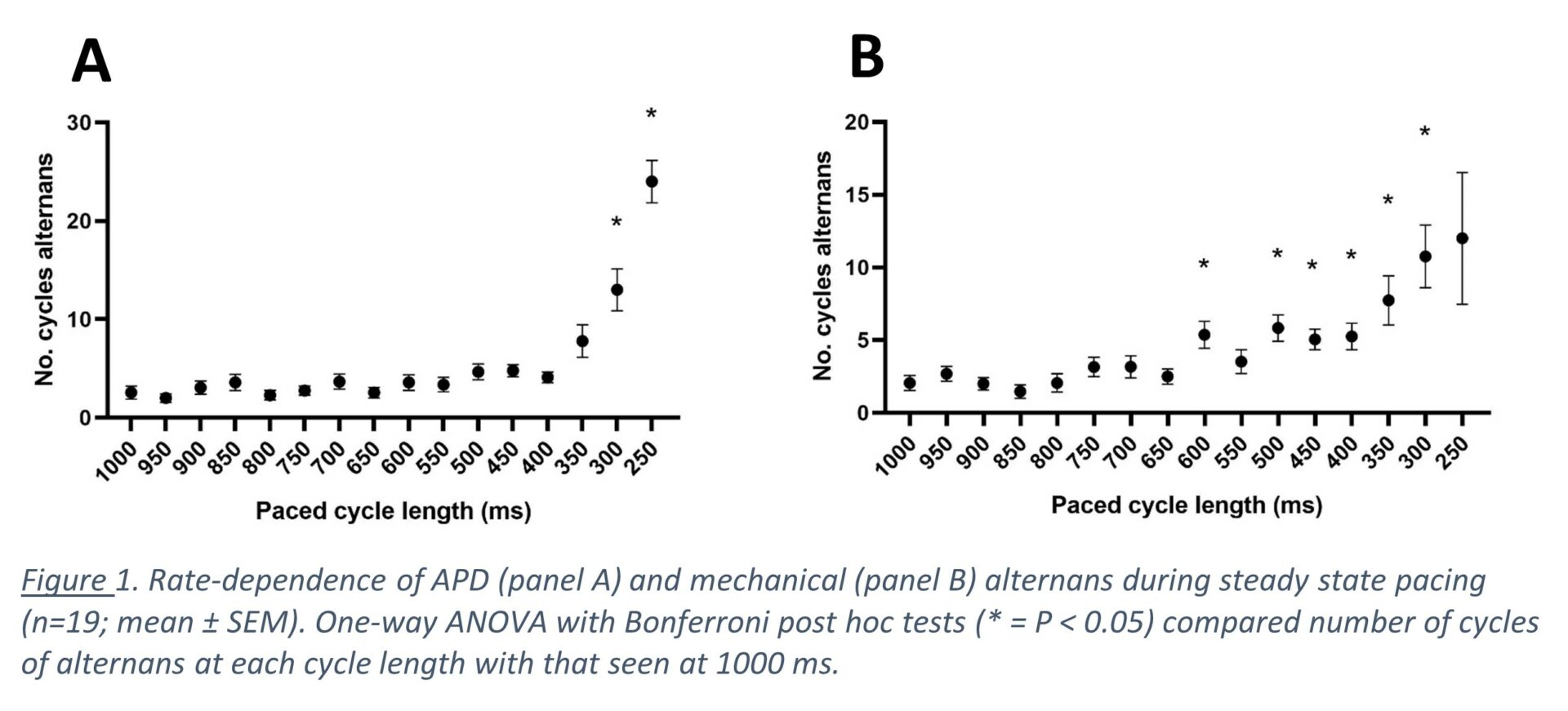Cardiac alternans is thought to promote arrhythmia via mechanisms including spatial dispersion of refractoriness resulting in wavebreak, thus promoting re-entry (Tse et al., 2016). The mechanisms underlying alternans remain unclear, particularly whether alternation in action potential duration (APD) or the calcium transient (CaT) is the primary disturbance (Díaz et al., 2004; Kanaporis & Blatter, 2017). One hypothesis is that at high pacing frequencies, alternation in the preceding diastolic interval (DI) can drive alternans, and that this is promoted when the slope of the restitution curve of dependence of APD on preceding DI exceeds 1 (Goldhaber et al., 2005). The present study investigated the cycle length (CL)-dependence of APD and mechanical (sarcomere shortening) alternans in ventricular myocytes isolated from male Dunkin-Hartley guinea pigs. Animal procedures were approved by the Animal Welfare and Ethics Review Board of the University of Bristol and performed in accordance with UK legislation. Excised hearts were mounted on a modified Langendorff apparatus and ventricular myocytes isolated as described previously (Gao et al., 2005). Sarcomere shortening changes were measured as an index of beat-to-beat changes in the CaT, in order to avoid potential buffering of cytosolic [Ca2+] by an intracellular Ca2+-sensitive fluorescent probe. Action potentials were recorded at physiological temperature (37 °C) in perforated-patch clamp measurements. Cells were paced in a steady state fashion by a train of 60 stimuli at constant CL during simultaneous recording of membrane potential and sarcomere length. The CL of the 60-stimuli train was progressively reduced to CL = 250 ms or 1:1 coupling was lost. Each train of 60-stimuli were preceded by 20 stimuli at a CL of 1,000 ms. Alternans was defined as 1:1 beat-to-beat alternation between long and short APD90 or large and small changes in sarcomere length. Data are presented as mean ± standard error of the mean. APD90 and mechanical alternans were seen in all cells (n=19); the incidence and duration of alternans increasing at shorter CLs (Figure 1). APD90 and mechanical alternans were observed to occur in isolation, as well as simultaneously (both in- and out-of-phase). Alternans occurred despite APD90 restitution slope steepness <1. In summary, the data show all cells demonstrated both APD90 and mechanical alternans. While alternans occurred through the range of CLs, there was clear CL-dependence of both APD90 and mechanical alternans. In conclusion, guinea pig ventricular myocytes demonstrate APD and mechanical alternans at a range of CLs, with a greater incidence at shorter CLs, which appears not to be dependent on steep APD90 restitution slope dynamics. Further work is required to understand intracellular processes underlying the generation of alternans.
Physiology 2021 (2021) Proc Physiol Soc 48, PC002
Poster Communications: Cycle length dependence of electrical and mechanical alternans in guinea pig ventricular myocytes
Alexander Carpenter1, Andrew Butler1, Julian Paton2, Jules C Hancox1, Andrew James1
1 School of Physiology, Pharmacology & Neuroscience, Biomedical Sciences Building, University of Bristol, BS8 1TD. , Bristol, United Kingdom 2 The University of Auckland, Auckland, New Zealand
View other abstracts by:
Where applicable, experiments conform with Society ethical requirements.

